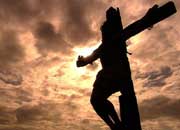The pastor at the church I attend has begun a series called Angels & Demons: winning the battle of heart and mind. Yes, my fellow Baptists, Methodists do believe in Angels and Demons. I heard the first part yesterday and did enjoy it. There were a few errors (the traditional ones) but there inevitably are when Christians start talking about an issue as nebulous as "Angels and Demons".
The only error on which I would like to comment is the identification of the Satan with the figure "Lucifer" from Isaiah 14:3-20. They are not the same character. In fact, as a LITERAL reading of the passage indicates, the oracle is about the human king of Babylon, not an angelic or demonic figure.
Now many will concede that the oracle is indeed about the King of Babylon and not specifically an angelic or demonic being but that the King is being compared to an angelic or demonic figure. In this way, some will use the comparison to construct a picture of this figure as being Lucifer or The Satan. I can certainly see that the poetics of verses 12-15 must refer to something other than a man but 16-20 obviously do refer to a man as does all that comes before verse 12.
But what about verses 12-15? Note verse 12:
"How you are fallen from heaven, O Day Star, son of Dawn!"
The Hebrew phrase "הילל בן־שׁחר" (Helel Ben-Shachar) in verse 12, means "day star, son of dawn". It can be translated "Day Star" or "Morning Star" and properly refers to the planet Venus. In the Latin Vulgate, Jerome translated the Hebrew as "lucifer qui mane oriebaris" (morning star that used to rise early).
There is no Scripture that connects Lucifer (the Morning/Day Star) with The Satan. This connection was made by inference and was mistaken. Because of some of the expressions contained in this these few verses, Christian tradition began to associate the "Morning/Day Star" or "Lucifer" figure as being identical with the Satan. A quite similar passage is found in Ezekiel 28:1-19, which is expressly directed against the king of Tyre.
Please not my definitive paper on the identity of the King of Tyre. The aptly named: The Satan and Ezekiel 28: Reasons Why These Two Are Not Connected
Indeed, the only figure in the Bible I can find that is referred to as the "Morning Star" is Jesus in Revelation 22:16:
"Jesus says: '... I am the root and the offspring of David, and the bright and morning star.'"
No, Isaiah is not referring to Jesus in verse 12.
So what then is going on?
I hold the position that Isaiah is comparing the King of Babylon, not to an angelic or demonic being, but to gods in the Canaanite mythology.
He uses the image of the Morning/Day Star, which rises at dawn as the brightest of the stars, outshining Jupiter and Saturn, but lasting only until the sun appears. This imagery was used in Canaanite mythology about the Morning/Day Star who tried to rise high above the clouds and establish himself on the mountain where the gods assembled, in the far north, but was cast down into the underworld. Just as the Roman poets personified the Morning/Day Star and the Dawn (Aurora), as well as the Sun and the Moon and other heavenly bodies, so in Canaanite mythology Morning/Day Star and Dawn were pictured as two deities, the former being the son of the latter.
That last point is very important. The Morning/Day Star was considered the Son of the Dawn. Isaiah 14:12 refers to the figure as "Day Star, son of Dawn."
How could "Lucifer" or the Satan, or any other angelic or demonic figure have a father?
True, angelic figures in the Bible are sometimes referred to as "sons of God" (Job 1:6), but the context here seems to suggest something other than identifying God with shachar (שחר), the Dawn. In light of its Canaanite origin, I do not think its tenable to identify this passage with The Satan.
We'll just have to settle for the mystery of his origins.
 "Thinking Eternally, Acting Locally." - Neal August
"Thinking Eternally, Acting Locally." - Neal August
No comments:
Post a Comment